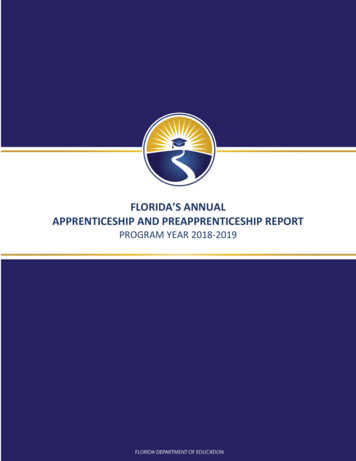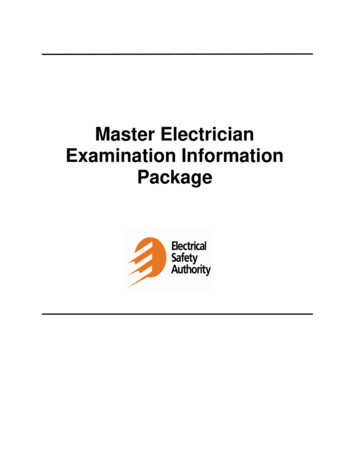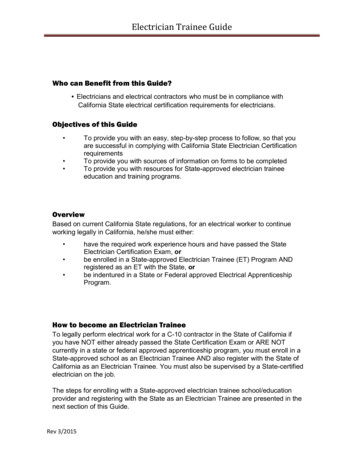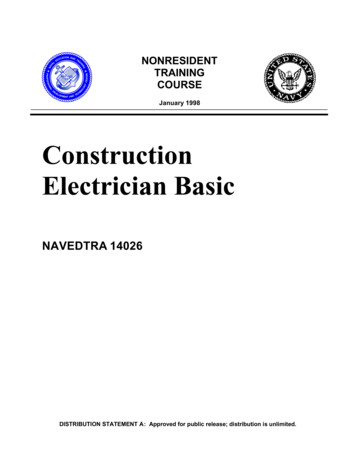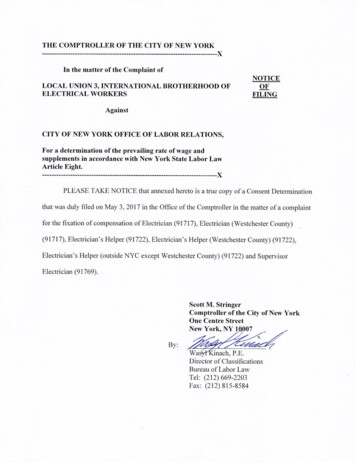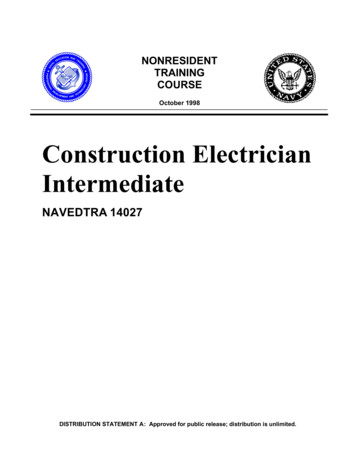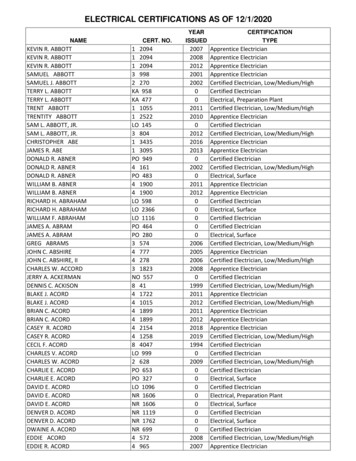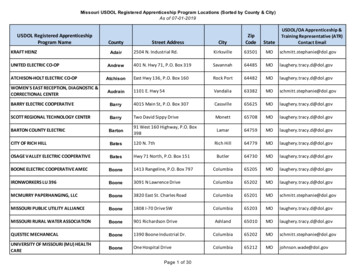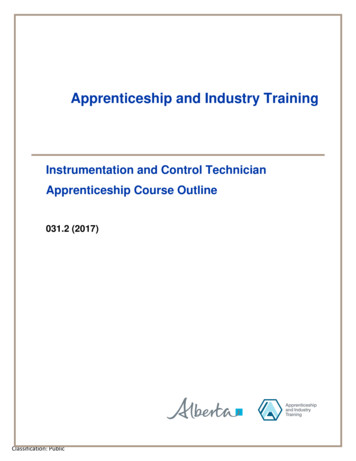
Transcription
Apprenticeship and Industry TrainingElectricianApprenticeship Course Outline003.3 (2014)Classification: Public
ALBERTA INNOVATION AND ADVANCED EDUCATIONElectrician: Apprenticeship Course OutlineISBN 978-1-4601-1611-1ALL RIGHTS RESERVED: 2014, Her Majesty the Queen in right of the Province of Alberta, as represented by the Minister of Alberta AdvancedEducation, 10th floor, Commerce Place, Edmonton, Alberta, Canada, T5J 4L5. All rights reserved. No part of this materialmay be reproduced in any form or by any means, without the prior written consent of the Minister of Advanced EducationProvince of Alberta, Canada. Revised 2016, 2017, 2020.Classification: Public
ElectricianTable of ContentsElectrician Table of Contents . 1Apprenticeship . 2Apprenticeship and Industry Training System . 2Apprenticeship Safety . 4Technical Training. 5Procedures for Recommending Revisions to the Course Outline . 5Apprenticeship Route toward Certification . 6Electrician Training Profile . 7Course OutlineFirst Period Technical Training . 14Second Period Technical Training. 23Third Period Technical Training. 32Fourth Period Technical Training . 38Classification: Public-1-
ApprenticeshipApprenticeship is post-secondary education with a difference. Apprenticeship begins with finding an employer.Employers hire apprentices, pay their wages and provide on-the-job training and work experience. Approximately80 per cent of an apprentice’s time is spent on the job under the supervision of a certified journeyperson orqualified tradesperson. The other 20 per cent involves technical training provided at, or through, a postsecondary institution – usually a college or technical institute.To become certified journeypersons, apprentices must learn theory and skills, and they must pass examinations.Requirements for certification—including the content and delivery of technical training—are developed andupdated by the Alberta Apprenticeship and Industry Training Board on the recommendation of the ElectricianProvincial Apprenticeship Committee.The graduate of the Electrician apprenticeship program is a certified journeyperson who will be able to: have a thorough knowledge and understanding of electrical theory and its application to lighting, powerand control equipment layout and install the various electrical circuits in residential, commercial, industrial and institutionalcomplexes and buildings implement the instructions given in plans and specifications pertaining to electrical installations be thoroughly familiar with the safety requirements for electrical installations be capable of trouble shooting and maintaining electrical systems and equipment competently use the test instruments and various tools necessary to perform tasks be familiar with the work of other tradespeople in the construction industry and with the different types ofbuilding construction perform assigned tasks in accordance with quality and production standards required by industryApprenticeship and Industry Training SystemIndustry-DrivenAlberta’s apprenticeship and industry training system is an industry-driven system that ensures a highly skilled,internationally competitive workforce in more than 50 designated trades and occupations. This workforce supportsthe economic progress of Alberta and its competitive role in the global market. Industry (employers andemployees) establishes training and certification standards and provides direction to the system through anindustry committee network and the Alberta Apprenticeship and Industry Training Board. The Alberta governmentprovides the legislative framework and administrative support for the apprenticeship and industry training system.Alberta Apprenticeship and Industry Training BoardThe Alberta Apprenticeship and Industry Training Board provides a leadership role in developing Alberta’s highlyskilled and trained workforce. The board’s primary responsibility is to establish the standards and requirementsfor training and certification in programs under the Apprenticeship and Industry Training Act. The board alsoprovides advice to the Minister of Advanced Education on the needs of Alberta’s labour market for skilled andtrained workers, and the designation of trades and occupations.The thirteen-member board consists of a chair, eight members representing trades and four membersrepresenting other industries. There are equal numbers of employer and employee representatives.Industry Committee NetworkAlberta’s apprenticeship and industry training system relies on a network of industry committees, including localand provincial apprenticeship committees in the designated trades, and occupational committees in thedesignated occupations. The network also includes other committees such as provisional committees that areestablished before the designation of a new trade or occupation comes into effect. All trade committees arecomposed of equal numbers of employer and employee representatives. The industry committee network is thefoundation of Alberta’s apprenticeship and industry training system.-2-Classification: Public
Local Apprenticeship Committees (LAC)Wherever there is activity in a trade, the board can set up a local apprenticeship committee. The board appointsequal numbers of employee and employer representatives for terms of up to three years. The committeeappoints a member as presiding officer. Local apprenticeship committees: monitor apprenticeship programs and the progress of apprentices in their trade, at the local level make recommendations to their trade’s provincial apprenticeship committee (PAC) about apprenticeshipand certification in their trade promote apprenticeship programs and training and the pursuit of careers in their trade make recommendations to the board about the appointment of members to their trade’s PAC help settle certain kinds of disagreements between apprentices and their employers carry out functions assigned by their trade’s PAC or the boardProvincial Apprenticeship Committees (PAC)The board establishes a provincial apprenticeship committee for each trade. It appoints an equal number ofemployer and employee representatives, and, on the PAC’s recommendation, a presiding officer - each for amaximum of two terms of up to three years. Most PACs have nine members but can have as many as twentyone. Provincial apprenticeship committees: make recommendations to the board about: standards and requirements for training and certification in their trade courses and examinations in their trade apprenticeship and certification designation of trades and occupations regulations and orders under the Apprenticeship and Industry Training Act monitor the activities of local apprenticeship committees in their trade determine whether training of various kinds is equivalent to training provided in an apprenticeshipprogram in their trade promote apprenticeship programs and training and the pursuit of careers in their trade consult with other committees under the Apprenticeship and Industry Training Act about apprenticeshipprograms, training and certification and facilitate cooperation between different trades and occupations consult with organizations, associations and people who have an interest in their trade and withemployers and employees in their trade may participate in resolving certain disagreements between employers and employees carry out functions assigned by the boardElectrician PAC Members at the Time of PublicationMr. D. Tangedal. Athabasca . Presiding OfficerMr. M. Engler . Slave Lake . EmployerMr. D. Kinley . Calgary . EmployerMr. C. Lofthaug. Edmonton . EmployerMr. K. Maclean . Fort McMurray . EmployerMs. C. McMillan . Cochrane . EmployerMr. N. Moffatt. Calgary . EmployerMr. C. Rauschning . Edmonton . EmployerMr. D. Chapman . Edmonton . EmployeeMr. S. Dyrkach. Beaverlodge . EmployeeMr. D. Greene. Olds . EmployeeMr. K. Helmer . Lloydminster . EmployeeMr. M. Kukura . Red Deer . EmployeeMr. S. Muggridge . Brooks. Employee-3-Classification: Public
Alberta GovernmentAlberta Advanced Education works with industry, employer and employee organizations and technical trainingproviders to: facilitate industry’s development and maintenance of training and certification standards provide registration and counselling services to apprentices and employers coordinate technical training in collaboration with training providers certify apprentices and others who meet industry standardsApprenticeship SafetySafe working procedures and conditions, incident/injury prevention, and the preservation of health are of primaryimportance in apprenticeship programs in Alberta. These responsibilities are shared and require the joint effortsof government, employers, employees, apprentices and the public. Therefore, it is imperative that all parties areaware of circumstances that may lead to injury or harm.Safe learning experiences and healthy environments can be created by controlling the variables and behavioursthat may contribute to or cause an incident or injury. By practicing a safe and healthy attitude, everyone canenjoy the benefit of an incident and injury free environment.Alberta Apprenticeship and Industry Training Board Safety PolicyThe Alberta Apprenticeship and Industry Training Board (board) fully supports safe learning and workingenvironments and emphasizes the importance of safety awareness and education throughout apprenticeshiptraining- in both on-the- job training and technical training. The board also recognizes that safety awareness andeducation begins on the first day of on-the-job training and thereby is the initial and ongoing responsibility of theemployer and the apprentice as required under workplace health and safety training. However the boardencourages that safe workplace behaviour is modeled not only during on-the-job training but also during allaspects of technical training, in particular, shop or lab instruction. Therefore the board recognizes that safetyawareness and training in apprenticeship technical training reinforces, but does not replace, employer safetytraining that is required under workplace health and safety legislation.The board has established a policy with respect to safety awareness and training:The board promotes and supports safe workplaces, which embody a culture of safety for allapprentices, employers and employees.Employer required safety training is theresponsibility of the employer and the apprentice, as required under legislation other thanthe Apprenticeship and Industry Training Act.The board’s complete document on its ‘Apprenticeship Safety Training Policy’ is available atwww.tradesecrets.alberta.ca; access the website and conduct a search for ‘safety training policy’.Implementation of the policy includes three common safety learning outcomes and objectives for all trade courseoutlines. These common learning outcomes ensure that each course outline utilizes common language consistentwith workplace health and safety terminology. Under the title of ‘Standard Workplace Safety’, this first section ofeach trade course outline enables the delivery of generic safety training; technical training providers will providetrade specific examples related to the content delivery of course outline safety training.-4-Classification: Public
Occupational Health and SafetyA tradesperson is often exposed to more hazards than any other person in the work force and therefore should befamiliar with and apply the Occupational Health and Safety Act, Regulations and Code when dealing withpersonal safety and the special safety rules that apply to all daily tasks.Occupational Health and Safety (a division of Alberta Human Services) conducts periodic inspections ofworkplaces to ensure that safety regulations for industry are being observed.Additional information is available at www.humanservices.albertaTechnical TrainingApprenticeship technical training is delivered by the technical institutes and many colleges in the public postsecondary system throughout Alberta. The colleges and institutes are committed to delivering the technicaltraining component of Alberta apprenticeship programs in a safe, efficient and effective manner. All trainingproviders place great emphasis on safety that complements safe workplace practices towards the development ofa culture of safety for all trades.The technical institutes and colleges work with Alberta’s Apprenticeship and Industry Training Board, industrycommittees and Alberta Advanced Education to enhance access and responsiveness to industry needs throughthe delivery of the technical training components of apprenticeship programs across the Province. They developcurriculum from the course outlines established by industry and provide technical training to apprentices.The following institutions deliver Electrician apprenticeship technical training:Northern Alberta Institute of TechnologyGrande Prairie Regional CollegeLakeland CollegeLethbridge CollegeKeyano CollegeMedicine Hat College (Brooks Campus)Southern Alberta Institute of TechnologyRed Deer CollegeNorthern Lakes CollegePortage CollegeProcedures for Recommending Revisions to the Course OutlineAdvanced Education has prepared this course outline in partnership with the Electrician Provincial ApprenticeshipCommittee.This course outline was approved on December 13, 2013 by the Alberta Apprenticeship and Industry TrainingBoard on a recommendation from the Provincial Apprenticeship Committee. The valuable input provided byrepresentatives of industry and the institutions that provide the technical training is acknowledged.Any concerned individual or group in the province of Alberta may make recommendations for change by writingto:Electrician Provincial Apprenticeship Committeec/o Industry Programs and StandardsApprenticeship and Industry TrainingAdvanced Education10th floor, Commerce Place10155 102 Street NWEdmonton AB T5J 4L5It is requested that recommendations for change refer to specific areas and state references used.Recommendations for change will be placed on the agenda for regular meetings of the Electrician ProvincialApprenticeship Committee.-5-Classification: Public
Apprenticeship Route toward CertificationAPPLICATIONCONTRACT AND RECORD BOOKENTRANCE EXAMINATIONReattemptPROOF RSEPASSFAILFIRST PERIOD1560 HOURS OF ON THE JOB TRAINING ANDSUCCESSFULLY COMPLETE TECHNICAL TRAININGSECOND PERIOD1560 HOURS OF ON THE JOB TRAINING ANDSUCCESSFULLY COMPLETE TECHNICAL TRAININGTHIRD PERIOD1560 HOURS OF ON THE JOB TRAINING ANDSUCCESSFULLY COMPLETE TECHNICAL TRAININGFOURTH PERIOD1440 HOURS OF ON THE JOB TRAINING ANDSUCCESSFULLY COMPLETE TECHNICAL TRAININGJOURNEYMAN CERTIFICATEINTERPROVINCIAL EXAMINATION FOR“RED SEAL”-6-Classification: Public
Electrician Training ProfileFIRST PERIOD(8 Weeks 30 Hours per Week – Total of 240 Hours)SECTION ONESTANDARD & SPECIFICWORKPLACE SAFETY12 HOURS ASafety Legislation,Regulations & IndustryPolicy in the Trades2 HoursDApprenticeship TrainingProgramBCClimbing, Lifting, Rigging &HoistingHazardous Materials & FireProtection2 HoursElectrical Safety2 HoursSECTION TWOCIRCUIT FUNDAMENTALS78 HOURS 2 HoursE4 HoursABCFirst Period MathApplicationsCurrent, Voltage, andResistanceSeries Resistive Circuits10 Hours10 Hours10 HoursDEFParallel Resistive CircuitsSeries-Parallel ResistiveCircuitsEdison 3-Wire DistributionSystems10 Hours14 Hours10 HoursGWork, Energy, Power andEfficiency14 HoursSECTION THREEAEMF SOURCES26 HOURS Methods of Producing EMFBCCells and BatteriesMagnetism andElectromagnetism4 Hours8 Hours10 HoursDGenerators4 HoursSECTION FOURLAB FUNDAMENTALS62 HOURS ABCMetersConductorsSplicing and Terminating(Low Voltage)4 Hours6 HoursEFResistorsSwitching CircuitsRelays and Controls2 Hours14 HoursGHExtra Low Voltage Switching(0-30v)Alarm Systems and SmokeAlarms10 Hours-7-Classification: Public2 HoursD10 Hours14 Hours
SECTION FIVECANADIAN ELECTRICAL CODEPART I AND DRAWINGS62 HOURS ABCIntroduction to CodeGeneral Rules – Section 2Conductor Material andSizes – Section 44 Hours4 HoursEFService and GroundingRequirementsService Feeders and BranchCircuits – Section 8Wiring Methods – Section 126 Hours6 Hours12 HoursGHIInstallation of ElectricalEquipment – Section 26Installation of LightingEquipment – Section 30Class 1 and Class 2 Circuits– Section 164 Hours4 Hours2 HoursJKLOrthographic Projection andDiagramsDrawingsDrawing Interpretation2 Hours-8-Classification: Public6 HoursD4 Hours8 Hours
SECOND PERIOD(8 Weeks 30 Hours per Week – Total of 240 Hours)SECTION ONEALTERNATING CURRENT(ac) CIRCUIT PROPERTIES36 HOURS ABCSecond Period MathApplicationsFundamentals of AlternatingCurrentPrinciples of ac Circuits6 Hours6 HoursEFInductance and InductiveReactanceCapacitance and CapacitiveReactancePower Relationships6 HoursSECTION TWO RLC CIRCUITSHEATING AND COOLINGSYSTEMS6 HoursBCSeries ac CircuitsSeries Resistive-ReactiveCircuitsSeries RLC Circuits10 Hours 42 HOURS12 HoursEFIntroduction to Parallel acCircuitsParallel RLC CircuitsPower Factor CorrectionSingle Phase10 HoursAPrinciples of AutomaticHeating and CoolingControls8 HoursD14 HoursCTemperature Sensing andControl DevicesBasic Gas-Fired Forced-AirHeating Systems4 HoursFBasic Hot Water HeatingSystemsCooling Systems4 HoursEHHVAC Rooftop UnitsHeat Trace6 Hours2 HoursABCElectrical Control DrawingsRelays and ContactorsTimers and Smart Relays42 HOURS2 Hours6 Hours4 HoursDEFProtection DevicesMotor StartersDiagram Conversion4 Hours7 HoursGHSingle Motor Control/ PilotDevices and SymbolsReversing Motor Starters7 Hours-9-Classification: Public6 HoursE4 Hours 14 HoursB8 HoursMAGNETIC CONTROLS ANDSWITCHING CIRCUITS14 HoursDEfficient Gas-Fired ForcedAir Heating SystemsSECTION FOUR6 HoursA74 HOURSSECTION THREE6 HoursD6 Hours6 Hours
SECTION FIVEACANADIAN ELECTRICAL CODEPART I / PLANS AND DIAGRAMS46 HOURS Service Conductor Ampacityfor a Single Dwelling4 HoursDGrounding Requirements fora Single Dwelling4 HoursGCapacitor Bank Installations2 HoursJSpecificationsService Ampacity forApartments and SimilarBuildings8 HoursHPools, Mobile Home andTemporary Wiring –Sections 68, 72 and 764 HoursKDrawings and Plans4 Hours- 10 -Classification: PublicBServices and ServiceEquipment for a SingleDwelling5 HoursE4 HoursCFeeder and BranchDistribution Requirements fora Single Dwelling3 HoursFService Protection andControl for Apartments andSimilar Buildings4 HoursIDiagrams4 Hours
THIRD PERIOD(8 Weeks 30 Hours per Week – Total of 240 Hours)SECTION ONETHREE PHASE PRINCIPLES98 HOURS ABCThird Period MathApplicationsThree-Phase SystemsThree-Phase WyeConnection12 Hours4 HoursEFThree-Phase DeltaConnectionThree-Phase Delta WyeConnectionThree-Phase PowerCalculations28 Hours8 HoursGHThree-Phase Measurementfor Power CalculationsThree-Phase Power FactorCorrection4 HoursSECTION TWOTHREE-PHASE MOTORPRINCIPLES56 HOURS 28 HoursD6 Hours8 HoursABCIntroduction to Three-PhaseInduction MotorsOperation of Three-PhaseInduction MotorsThree-Phase Motors andStarters12 Hours12 Hours24 HoursDIntroduction to VariableFrequency Drives8 HoursSECTION THREE TRANSFORMERSABCIntroduction to TransformersTransformer Operation(Single-Phase Transformers)Autotransformers34 HOURS4 Hours8 HoursDETransformer Connections(Three-Phase Transformers)Energy Measurement14 HoursSECTION FOURCANADIAN ELECTRICAL CODE52 HOURS 6 HoursABCGrounding and Bonding Section 10Protection and Control Section 14Installation of Equipment Section 266 Hours10 Hours6 HoursDEFIndividual MotorsMotor BanksHazardous Locations –Section 186 Hours6 HoursGHClass 1 Locations Section 20Corrosive and Wet Locations- Section 224 Hours- 11 -Classification: Public2 Hours2 Hours12 Hours
FOURTH PERIOD(12 Weeks 30 Hours per Week – Total of 360 Hours)SECTION ONEMACHINES62 HOURS ABCFourth Period MathApplicationsAlternators and GeneratorsDirect Current (dc) Machines14 Hours8 HoursEFAlternatorsSynchronous MotorsSingle-Phase Motors16 HoursSECTION TWOCONTROL AND SWITCHING/PLC 8 HoursBCDrawings and Basic CircuitsDiagram ConversionControls and SwitchingCircuits8 Hours8 HoursDESpecial Control CircuitsProgrammable LogicControllers10 HoursFIRE ALARM SYSTEMS42 HOURS 30 HoursBCFire Detection and AlarmSystemsFire Detection and AlarmSystem RegulationsFire Alarm SystemOccupancy Classifications6 Hours6 Hours70 HOURS 6 HoursDEFWiring Procedures for FireAlarm SystemsArc Flash and ElectricalSafetyInterprovincial StandardsRed Seal Program6 HoursGHAlberta’s Industry NetworkWorkplace Coaching Skills2 HoursAPPLICATIONS OFELECTRONICS18 HoursA12 HoursSECTION FOUR6 HoursA74 HOURSSECTION THREE10 HoursD2 Hours2 HoursABCRectifiers and BatteryChargersWelders and FiltersControlled Rectifiers20 Hours10 Hours10 HoursDEFUninterruptible Power SupplySystemsVariable Frequency DrivesCathodic Protection10 Hours10 Hours2 HoursGRenewable Energy Systems8 HoursSECTION FIVECANADIAN ELECTRICAL CODEPART 1 / APPLICATIONS ANDSAFETY112 HOURSA BConductors – Section 48 HoursWiring Methods – Section 12GLighting, EmergencySystems and Unit Equipment– Sections 30 and 4610 HoursH14 HoursFCommunication Systems andCabling –Sections 54, 56 and 604 HoursIElectrical Requirements for aSingle Dwelling – Section 8Electrical Requirements forApartments – Section 8Individual Motors and MotorBanks – Section 28DProtection and Control –Section 1412 Hours4 Hours- 12 -Classification: PublicCGrounding and Bonding andDistribution Layout –Section106 HoursE6 Hours6 Hours
JKInstallation of Capacitors andTransformers – Section 26Electric Welders –Section 426 HoursMElectrical Installations inPatient Care Areas –Section 242 Hours2 HoursNHigh-Voltage – Section 3610 HoursLHazardous and SpecialLocations –Sections 18, 20 and 2212 HoursOOccupational Applications10 HoursNOTE: The hours stated are for guidance and should be adhered to as closely as possible. However,adjustments must be made for rate of apprentice learning, statutory holidays, registration and examinations forthe training establishment and Apprenticeship and Industry Training.- 13 -Classification: Public
FIRST PERIOD TECHNICAL TRAININGELECTRICIAN TRADECOURSE OUTLINEUPON SUCCESSFUL COMPLETION OF THIS PROGRAM THE APPRENTICE SHOULD BE ABLE TOPERFORM THE FOLLOWING OUTCOMES AND OBJECTIVES.SECTION ONE: . STANDARD & SPECIFIC WORKPLACE SAFETY . 12 HOURSA.Safety Legislation, Regulations & Industry Policy in the Trades . 2 HoursOutcome:B.1.Demonstrate the application of the Occupational Health and Safety Act, Regulation and Code.2.Describe the employer’s and employee’s role with Occupational Health and Safety (OH&S)regulations, Worksite Hazardous Materials Information Systems (WHMIS), fire regulations,Workers Compensation Board regulations and related advisory bodies and agencies.3.Describe industry practices for hazard assessment and control procedures.4.Describe the responsibilities of worker and employers to apply emergency procedures.5.Describe tradesperson attitudes with respect to housekeeping, personal protective equipmentand emergency procedures.6.Describe the roles and responsibilities of employers and employees with the selection and useof personal protective equipment (PPE).7.Maintain required PPE for tasks.8.Use required PPE for tasks.Climbing, Lifting, Rigging and Hoisting . 2 HoursOutcome:C.Apply legislation, regulations and practices ensuring safe work in this trade.Use industry standard practices for climbing, lifting, rigging and hoisting in thistrade.1.Describe manual lifting procedures.2.Describe rigging hardware and associated safety factors.3.Select equipment for rigging loads.4.Describe hoisting and load moving procedures.5.Maintain personal protective equipment (PPE) for climbing, lifting and load moving equipment.6.Use PPE for climbing, lifting and load moving equipment.Hazardous Materials & Fire Protection. 2 HoursOutcome:Apply industry standard practices for hazardous materials and fire protection inthis trade.1.Describe roles, responsibilities, features and practices related to the Workplace HazardousMaterials Information System (WHMIS) program.2.Describe three key elements of WHMIS.3.Describe handling, storing and transporting procedures for hazardous material.4.Describe venting procedures when working with hazardous materials.5.Describe hazards, classes, procedures and equipment related to fire protection.- 14 -
FIRST PERIODD.Apprenticeship Training Program . 2 HoursOutcome:E.Manage an apprenticeship to earn journeyman certification.1.Describe the contractual responsibilities of the apprentice, employer and AlbertaApprenticeship and Industry Training.2.Describe the purpose of the apprentice record book.3.Describe the procedure for changing employers during an active apprenticeship.4.Describe the purpose of the course outline.5.Describe the procedure for progressing through an apprenticeship.6.Describe advancement opportunities in this trade.Electrical Safety . 4 HoursOutcome:Apply safe work practices for electricians.1.Identify the safe work practices to protect from arc flash hazards.2.Identify and describe lockout procedures.3.Identify the safe work practices to prevent electrical shock.4.Describe the use of common hand tools and equipment related to the electrician trade.5.Describe the use of common power and specialty tools related to the electrician trade.SECTION TWO: . CIRCUIT FUNDAMENTALS .78 HOURSA.First Period Math Applications. 10 HoursOutcome:B.1.Recognize basic arithmetic symbols.2.Add and subtract whole, decimal and fractional numbers.3.Multiply and divide whole, decimal and fractional numbers.4.State the correct sequence for arithmetical operations and solve equations which use brackets.5.Apply the math skill required for transposition of equations in relation to Ohm’s Law.Current, Voltage and Resistance . 10 HoursOutcome:C.Solve trade-related problems using basic mathematical skills.Predict how changes in the value of voltage, current or resistance affects thecircuit.1.Describe an electric current.2.Describe voltage.3.Describe resistance and state and apply Ohm’s Law.4.Connect and verify relationship between voltage, current and resistance according to Ohm’sLaw.Series Resistive Circuits . 10 HoursOutcome:Connect and analyze a series resistive circuit.1.Identify a series circuit.2.Calculate resistance in a series circuit.- 15 -Classification: Public
FIRST PERIODD.3.State and apply Kirchhoff’s Voltage Law in a series circuit.4.Calculate current in a series circuit.5.Determine circuit values by applying ratio and proportion.6.Solve series circuits using the voltage divider rule.7.Determine the voltage drop across closed-or-open components in a series circuit.8.Connect and analyze Kirchhoff’s Voltage Law in a series resistive circuit.Parallel Resistive Circuits . 10 HoursOutcome:E.1.Describe a parallel circuit.2.Calculate resistance in a parallel circuit.3.State and apply Kirchhoff’s Current Law to a parallel circ
the delivery of the technical training components of apprenticeship programs across the Province. They develop curriculum from the course outlines established by industry and provide technical training to apprentices. The following institutions deliver Electrician
